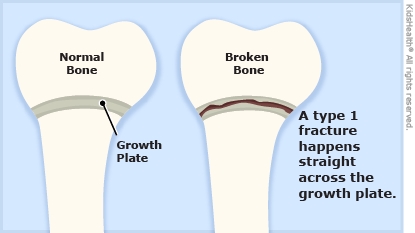Possible Growth Plate Fracture: How to Care for Your Child
When an injury is new, swelling and pain can make it hard to tell if a child has a sprain, a strain, or a mild fracture in the growth plate of a bone. Using a splint or a boot will support the injury until the swelling goes down and a specialist can recheck your child.


-
To control swelling, for the first 1‒2 days:
-
Use pillows to raise the injured area above heart level when your child is sitting or lying down.
-
When your child is awake, put ice in a plastic bag wrapped in a towel on the injured area for 20 minutes every 3 hours for up to 2 days. Don't put ice directly on the splint or skin.
-
Your child should rest the injured part of the body and not do activities that cause pain.
If your child has pain:
-
When your child is awake, put ice in a plastic bag wrapped in a towel on the injured area for 20 minutes every 3 hours for up to 2 days. Don't put ice directly on the splint or skin.
-
You can give medicine for pain if your health care provider says it's OK. Use these medicines exactly as directed:
-
acetaminophen (such as Tylenol® or a store brand)
-
OR
-
ibuprofen (such as Advil®, Motrin®, or a store brand). Do not give to babies under 6 months old.
If your child has a boot:
-
Use it as instructed. If it's OK with your health care provider, you can remove the boot for a bath or shower and for sleep.
-
If your child was asked to use crutches, make sure he or she does so safely.
If your child has a splint:
-
Don't remove or change the position of the splint.
-
Check the area around the splint every day. Make sure the skin isn't scratched and the area isn't pale, blue, numb, or tingling.
-
Make sure your child doesn't pick at the lining of the splint or scratch under it.
-
Don't put anything in the splint. Make sure your child doesn't put toys, food, or other objects into it.
-
Keep dirt, sand, lotion, and powder away from the splint.
-
Keep the splint dry:
-
No swimming.
-
Give sponge baths to kids younger than 5 years old.
-
Older kids should take baths instead of showers.
-
Put a plastic covering over the splint when your child bathes. Put the injured part of the body and splint on something to keep them completely out of the water.
-
If the splint gets splashed, gently blow air onto it from a hair dryer on the cool setting.
Problems to watch for:
-
Itching: Tap lightly on the splint or use a hair dryer on the cool setting to blow air in and around the edges.
-
Swelling: If the fingers or toes near the splint look puffy, raise the injured area of the body above the level of the heart for 1 hour. If the swelling doesn't get better, call your health care provider.
Be sure to:
-
Follow up with the orthopedic specialist as directed.
-
Have your child avoid gym class, sports, and playground equipment until the orthopedic specialist says it's OK.

Your child:
-
has pain that continues while taking pain medicine
-
has pain that gets worse
-
gets a fever with no clear reason
-
has red or raw skin near the edge of the splint
-
feels the splint is too tight

-
Your child has severe pain, numbness, or tingling in the injured area.
-
The injured body part gets pale or turns blue.
-
The splint is loose or damaged, gets very wet inside, or smells bad.

What is the difference between a sprain, a strain, and a growth plate fracture?
-
A sprain is an injury to a ligament (stretchy band connecting two bones).
-
A strain is an injury to a tendon (stretchy band connecting muscle to bone).
-
A growth plate fracture is an injury to the part of the bone that is still growing.
What is a growth plate? Growth plates are areas of active new bone growth. They're made up of cartilage, a rubbery, flexible material (the nose, for instance, is made of cartilage). When kids are done growing, growth plates harden into solid bone. This happens in girls around ages 13–15 and in boys around ages 15–17.
How does a growth plate fracture happen? While kids are still growing, growth plates are weaker than the rest of the bone, so growing kids who fall can get a growth plate fracture.
How is a growth plate fracture diagnosed? Health care providers will order X-rays if they think a bone is broken. Some mild growth plate fractures might not show up on an X-ray, though. So even when an X-ray is normal, if a growing child has pain in the area of a growth plate, health care providers will often use a splint or brace, like a boot, to protect it.
Will my child need a cast? Maybe. Your child will wear the splint or boot until a follow-up appointment with an orthopedic specialist. The specialist will recheck your child's injury and decide whether there is a sprain, strain, or fracture. The specialist will let you know if the injury needs a cast, or if the splint or boot is best.